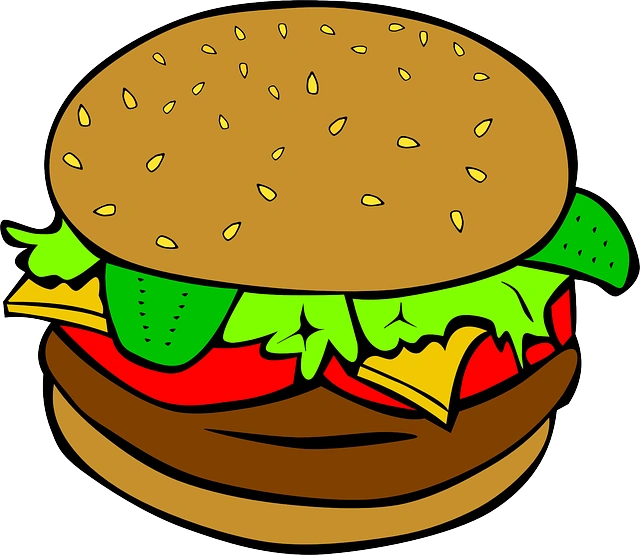The global fast-food burger market is highly competitive, known as the "Burger Challenge." Businesses must navigate a vibrant landscape of established chains and startups by understanding consumer trends, innovating through menu diversification, sustainability, or digital transformation, and staying ahead with constant adaptations. Direct competitors like McDonald's, Burger King, and Wendy's offer similar burgers, while indirect competitors provide alternative dining experiences. Strategic market positioning is key, differentiating from rivals through unique ingredients, twists, or eco-friendly practices to attract specific customer segments. Pricing strategies, from cost-plus to premium, cater to diverse consumer behaviors. Menu engineering, based on data analytics of customer behavior and preferences, optimizes offerings for increased satisfaction and sales. Data insights can reveal hidden patterns, enabling clever marketing strategies to gain a competitive edge in the burger challenge.
“Unravel the secrets of the competitive burger market with our comprehensive guide. The ‘Burger Challenge’ presents a dynamic landscape where understanding direct and indirect competitors is key to success. This article navigates the strategic aspects, from market positioning and pricing strategies to menu engineering and customer behavior insights. By analyzing these elements, you’ll gain a powerful edge in the fast-food sector, ensuring your burger business stands out amidst the competition.”
- Understanding the Burger Challenge: A Competitive Landscape Overview
- Identifying Direct and Indirect Competitors
- Market Positioning: Differentiating Your Burger Business
- Competitive Pricing Strategies in the Fast-Food Sector
- Menu Engineering: Unlocking Winning Combinations
- Customer Insights: Gaining an Edge Through Behavior Analysis
Understanding the Burger Challenge: A Competitive Landscape Overview

The “Burger Challenge” isn’t just a catchy phrase; it represents the intense competitive landscape within the global fast-food industry, particularly in the segment dedicated to burgers. This challenge involves not only understanding consumer preferences but also keeping pace with rapidly evolving market trends and innovations. The burger market is a vibrant tapestry of established chains and emerging startups, each vying for a share of consumers’ taste buds. From classic American-style burgers to gourmet options with unique toppings and sauces, the competition is fierce.
To navigate this competitive landscape, businesses must analyze their offerings, pricing strategies, and marketing approaches. Staying ahead often means embracing innovation, whether it’s through menu diversification, sustainable practices, or digital transformation. The Burger Challenge encourages companies to constantly adapt and improve, ensuring they remain relevant in a market where the next big bite could come from anywhere, at any time.
Identifying Direct and Indirect Competitors

Identifying direct and indirect competitors is a crucial step in any competitive research, especially when diving into the world of the Burger Challenge. Direct competitors are those offering similar products or services within the same market segment. For instance, in the Burger Challenge scenario, fast-food chains like McDonald’s, Burger King, and Wendy’s would be considered direct rivals as they all serve burgers and compete for the same customer base. These companies directly compete on price, quality, taste, and marketing strategies.
Indirect competitors, on the other hand, offer alternative products or services that still satisfy a similar customer need. For example, a sit-down restaurant specializing in gourmet burgers might be seen as an indirect competitor because, while not offering fast food, it caters to burger enthusiasts looking for a different dining experience. Identifying these competitors helps businesses understand the full scope of their competition and tailor their strategies accordingly, whether it’s through differentiating their offerings or finding unique ways to meet consumer demands.
Market Positioning: Differentiating Your Burger Business

In the competitive world of burger joints, standing out from the pack is no small feat. Market positioning is a strategic move that can help your burger business carve its niche and face the intense burger challenge. The key lies in differentiation—creating a unique selling proposition that sets your burgers apart. Is it an innovative recipe with locally sourced ingredients? Perhaps a playful twist on a classic patty? Maybe it’s an eco-friendly, sustainable approach to fast food.
By focusing on what makes your burgers special, you can attract a specific customer base that values these differences. For instance, health-conscious consumers might be drawn to your plant-based options, while families could be enticed by portion sizes and kid-friendly menu items. Effective market positioning ensures your business doesn’t just blend in; it becomes a go-to choice for customers seeking something distinct from the standard burger offerings.
Competitive Pricing Strategies in the Fast-Food Sector

In the fast-food sector, competitive pricing strategies play a pivotal role in attracting and retaining customers, especially during the highly competitive burger challenge. One common approach is cost-plus pricing, where restaurants set prices based on the cost of ingredients plus a markup. This method allows for some flexibility in adjusting prices according to market demands and competitor actions. For instance, during promotional events or when introducing new menu items, fast-food chains might offer discounted prices to gain a competitive edge.
Another strategy is penetration pricing, where initial prices are set lower than competitors to quickly capture market share. While this may attract price-sensitive consumers, it requires careful monitoring of costs to maintain profitability. Conversely, premium pricing positions fast food as a luxury option, targeting customers willing to pay a higher price for quality and convenience. Restaurants often use this strategy to differentiate themselves by emphasizing unique ingredients, better sourcing, or superior preparation methods, such as crafting burgers with artisanal ingredients or offering plant-based options.
Menu Engineering: Unlocking Winning Combinations

Menu engineering is a powerful strategy for restaurants and food establishments, especially in competitive markets like the burger challenge. It involves carefully curating and optimizing menu options to enhance customer satisfaction, increase sales, and gain a competitive edge. By analyzing consumer preferences, behavior, and pricing dynamics, businesses can create winning combinations of dishes that cater to diverse tastes while maximizing profitability.
This approach goes beyond simply adding or removing items from the menu. It includes strategic placement, pricing strategies, and promotions to ensure each dish complements one another. For instance, in a burger challenge, offering a variety of unique, high-quality burgers at different price points can attract a broad customer base. Accompanying sides and desserts that pair well with burgers can further enhance the dining experience, encouraging customers to choose multiple items from the menu, thereby increasing revenue per order.
Customer Insights: Gaining an Edge Through Behavior Analysis

In the competitive world of quick-service restaurants, understanding customer behavior is a game-changer, especially when it comes to the iconic burger challenge. By analyzing consumer actions and preferences, businesses can gain valuable insights that set them apart from competitors. This strategy involves studying not just what customers buy but also how they interact with menu items, pricing structures, and promotional offers. For instance, identifying trends in burger orders—such as preferred toppings or side choices—can help restaurants tailor their menus to meet specific tastes.
Through advanced data analytics, companies can unearth hidden patterns and make informed decisions. Say, for example, a restaurant notices that a certain burger with unique ingredients consistently draws more customers during off-peak hours. This insight could lead to clever marketing strategies, like promoting this burger as a “hidden gem” during quieter periods, thus attracting new clients and gaining a competitive edge in the burger challenge arena.
